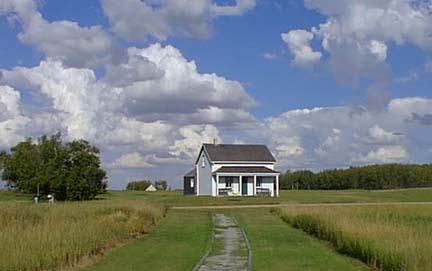|
|
|
| FTLComm - Batoche - September 11, 1999 | |
| On Labour Day we went over to Duck Lake to visit the National Historical site at
Batoche. Though fall is beginning one can easily imagine what the same country side
would have looked like in May of 1885 when the British lead expeditionary force arrived
on the prairies to invade the land held by the Metis who had fled repression near
Winnipeg only a few years before. From the moment we got out of the van we realised this was just our survey visit to this site and that we would have to come back several times to get an insight into this tragic and brutal colonial attack on the people who were attempting to make their home here along the Saskatchewan River. The structure that is as out of place on this site as the forces lead e interpretive Centre is an ultra modern aluminum and |
 |
| glass by General Middleton and accompanied by weapons salesmen from the United States
eager to show off the effectiveness of their newly invented machine gun. The Centre has one of the most modern audio visual systems in Western Canada custom made by Sony for this Centre it replaced eighteen slide projectors. However, it was not working today and we would have to come back another day to see this outstanding presentation that might help us get an over all view of what historians now believe to have happened. Since we couldn't see the presentation we decided to take a look at he place from the perspective of General Middleton and his massive force that had worked its way across Canada on the new railroad to somewhere in Manitoba where they loaded up their wagons and hit off across country then part way by boat and ultimately arrive on the field in the picture below. |
|
 |
|
| It was on this expanse of ground about a mile from and well above the Metis village
of Batoche that Middleton set up his camp. Essentially his troops built a little
fortress with earthen walls, their wagons around the outside to serve as cover and
they also dug in trenches and gun emplacements. The farm house, owned by Jean Caron,
seen in this picture was on the edge of the fortress and was burned down to remove
it as cover for Metis snipers. Middleton's camp was not only well equipped and manned compared to the folks in the village but was on the high ground strategically positioned from which to launch an assault or make a stand against the Metis who might try and attack them in their position. |
|
 Jean Caron and his sons had joined the villagers to defend their community from the Eastern hostile force and after the conflict this house was built on the site of the original. This picture is looking East from the River bank at the house and in the distance you can see a tent sitting almost precisely where Middleton's tent had stood one hundred and fourteen years ago. The trenches are still there by the trees as we look past the house on its right side. Between the house and the trees Middleton's stockade, corral and battlements were all located. |
|
 This picture is taken from the same spot as the one above and this is the scene that Middleton's riflemen commanded over the banks of the river where they were positioned to prevent Metis snipers from sneaking up on their flank. The village of Batoche is to the right of this picture, around the bend. This first trip to Batoche was from the outsider's point of view, how the countryside looked from the South just a mile away from the village's steeple which was visible from the Middleton camp. The beauty of the place is in such sharp contrast to the ugly purpose of Prime Minister, John A. MacDonald's army that came to this place to take the land from these people. |
|
| The QuickTime VR panorama of the magnificence of the Saskatchewan River Valley is as it is today but it would have looked much the same in 1885. | |
